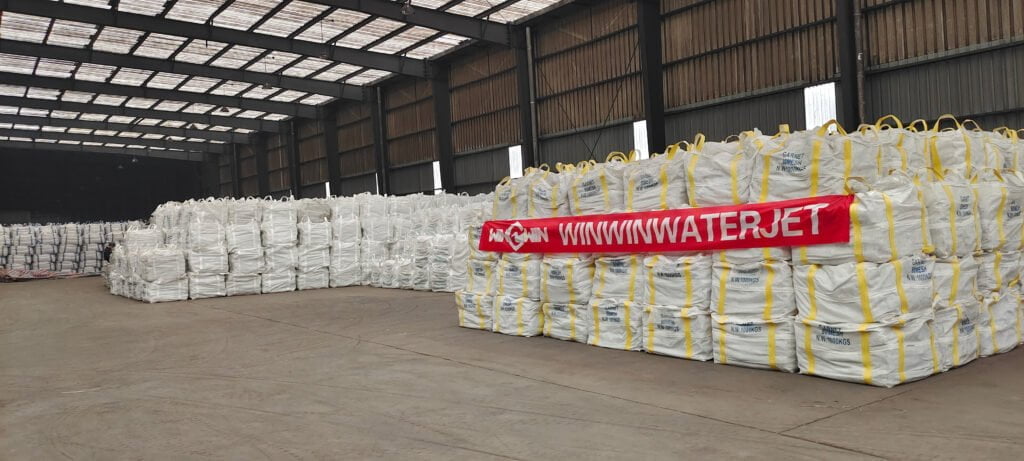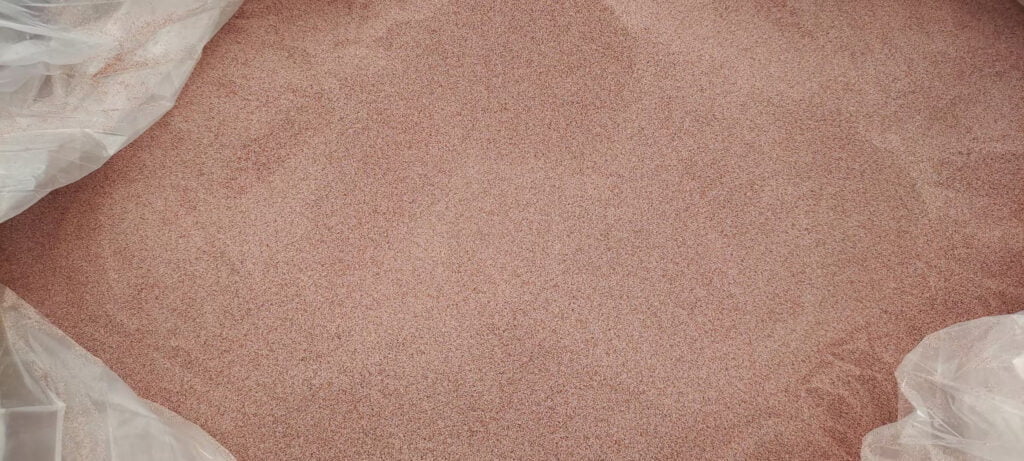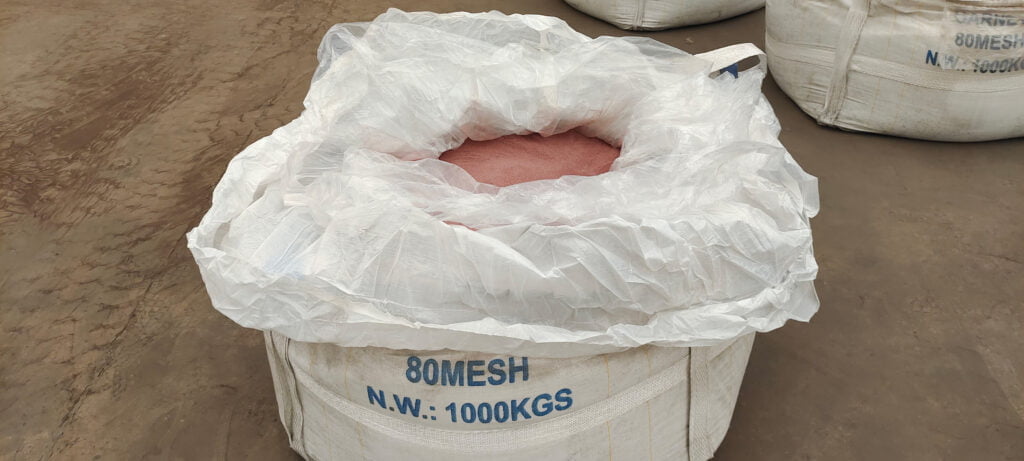
Contenu

Water jet cutting is a versatile cutting method that can be used to cut a wide range of materials with varying thicknesses and geometries. Water jet abrasives allows for faster cutting speeds and more precise cuts than water-only cutting, making it a popular choice in many industries.
Type d’abrasif pour jet d’eau
Le type de Abrasif pour jet d’eau used depends on the material being cut and the desired cutting speed and precision. Here are some of the most common water jet abrasives used in cutting:
1. Garnet
Garnet is a natural mineral that is hard and durable, making it ideal for cutting materials such as metals, glass, and composites. It is the most common water jet abrasive used in water jet cutting. Coarser grades are typically used for faster cutting speeds, while finer grades are used for a smoother finish.
Avantages spécifiques de l’utilisation du grenat
a. Cost-effectiveness
Garnet is relatively inexpensive compared to other water jet abrasives, making it a cost-effective choice for many water jet cutting applications.
For example, while the cost of aluminum oxide can range from around $1.50 to $4.00 per pound, the cost of garnet can range from around $0.15 to $0.50 per pound. The cost of silicon carbide can be even higher, ranging from around $2.50 to $5.00 per pound.
However, it’s important to note that the cost of the water jet abrasive is just one factor to consider when selecting the right abrasive for a specific application.
b. Availability
Garnet is widely available and can be easily sourced from many suppliers, making it a convenient choice for water jet cutting.
c. Versatility
Garnet is a versatile water jet abrasive that can be used to cut a wide range of materials, including metals, composites, and plastics.
d. Durability
Garnet is hard and durable, which allows for faster cutting speeds and longer life of the abrasive.
e. Low dust generation
Garnet produces less dust and debris than other water jet abrasives, which makes it a safer and cleaner choice for water jet cutting.
f. Consistency
Garnet abrasives are available in a wide range of grades, which allows for consistent and precise cutting performance.

2. Aluminum oxide
Aluminum oxide is another popular water jet abrasive. It is a synthetic abrasive that is often used in water jet cutting applications where a finer finish is desired. It is harder and more durable than garnet, which makes it ideal for cutting harder materials such as ceramics and titanium.
3. Silicon carbide
Silicon carbide is a synthetic abrasive that is used for cutting hard and brittle materials such as ceramics, glass, and stone. It is also a kind of water jet abrasive usually used, which involves mixing the abrasive with water and then spraying it onto the material being cut.
4. Diamond
Diamond is the hardest known mineral and is used for cutting extremely hard materials such as tungsten carbide and sapphire. Diamond abrasives are more expensive than other types of water jet abrasives and are typically used only in specialized applications where high precision and quality are required.
Taille de l’abrasif pour jet d’eau
There are several different water jet abrasive sizes available for cutting, and the recommended size will depend on the specific application and material being cut. Here are some general guidelines for common water jet abrasive sizes and their recommended thicknesses:
1. 80 mesh (200 microns)
This is a coarse abrasive size that is typically used for cutting thicker materials, such as metals, composites, and ceramics. It is recommended for materials with a thickness of 1 inch (25 mm) or greater.
2. 120 mesh (125 microns)
This is a medium abrasive size that is suitable for cutting a wide range of materials, including metals, plastics, and composites. It is recommended for materials with a thickness of 1/2 inch (13 mm) or greater.
3. 220 mesh (63 microns)
This is a fine abrasive size that is suitable for cutting thinner materials, such as plastics, composites, and some metals. It is recommended for materials with a thickness of 1/4 inch (6 mm) or greater.
4. 320 mesh (45 microns)
This is a very fine abrasive size that is typically used for cutting very thin materials, such as electronic components and thin metals. It is recommended for materials with a thickness of less than 1/4 inch (6 mm).

Aspects influencés par la taille des particules de l’abrasif à jet d’eau
The type and particle size of water jet abrasive used in cutting can have an impact on the cutting speed, precision, and finish of the cut. It’s important to choose the right water jet abrasive for the specific material being cut and to ensure that the abrasive is of high quality and properly matched to the water jet cutting machine. Here are some aspects can be influenced by the particle size of the water jet abrasive:
1. Cutting speed
The particle size of the abrasive can affect the cutting speed of the water jet. Coarser abrasives, such as larger particles of garnet or aluminum oxide, can cut faster than finer abrasives. This is because coarser abrasives are heavier and can transfer more energy to the material being cut, resulting in faster cutting speeds.
2. Finish quality
The particle size of the abrasive can also affect the finish quality of the cut. Finer abrasives, such as smaller particles of garnet or aluminum oxide, can produce a smoother finish than coarser abrasives. This is because finer abrasives remove less material with each pass, resulting in a finer finish.
3. Kerf width
The particle size of the abrasive can also affect the kerf width, or the width of the cut. Coarser abrasives can produce wider kerf widths than finer abrasives, which can be important in applications where tight tolerances are required.
4. Material removal rate
The particle size of the abrasive can affect the material removal rate, or the amount of material that is removed per unit of time. Coarser abrasives can remove more material per unit of time than finer abrasives, which can be important in applications where high material removal rates are required.
Facteurs influençant le choix de l’abrasif à jet d’eau
When selecting the type of water jet abrasive to use in cutting, it’s also important to consider the material being cut, the desired cutting speed and precision, and the cost and availability of the abrasive. It’s also vital to ensure that the abrasive is properly matched to the water jet cutting machine to ensure optimal performance and quality of the cut.
When selecting the right water jet abrasive for a specific material in water jet cutting, there are several factors to consider. Here are some of the most important factors to keep in mind:
1. Material hardness
The hardness of the material being cut is one of the most important factors to consider when selecting the right water jet abrasive. Harder materials typically require harder and more durable water jet abrasives, such as aluminum oxide or diamond, while softer materials can be cut with softer and less expensive water jet abrasives, such as garnet.
2. Material thickness
The thickness of the material being cut can also affect the choice of water jet abrasive. For thicker materials, coarser abrasives may be used to allow for faster cutting speeds, while finer abrasives may be used for thinner materials to achieve a smoother finish. For very thick materials, multiple passes may be required to cut through the material. In this case, a coarser abrasive may be used for the initial pass to remove most of the material, followed by a finer abrasive for subsequent passes to achieve a smoother finish.
3. Material composition
The composition of the material being cut can affect the choice of water jet abrasive as well. For example, materials with high levels of silica, such as glass and ceramics, may require water jet abrasives that are harder and more durable, such as silicon carbide.
4. Cutting speed and precision
The desired cutting speed and precision can also affect the choice of water jet abrasive. Harder and more durable water jet abrasives can allow for faster cutting speeds, but may produce rougher finishes. Finer water jet abrasives can produce smoother finishes, but may require longer cutting times.
5. Cost and availability
The cost and availability of the water jet abrasive should also be considered. Some water jet abrasives, such as garnet, are widely available and relatively inexpensive, while others, such as diamond, are more expensive and may require specialized equipment.
6. Cutting environment
The cutting environment can affect the choice of water jet abrasive. For example, if the cutting is being done in a clean room environment, a low-dust abrasive may be required to prevent contamination.
7. Machine specifications
The specifications of the water jet cutting machine being used can also affect the choice of water jet abrasive. Some machines may require specific types or sizes of water jet abrasives, or may have limitations on the type of abrasive that can be used.
8. Surface finish requirements
The desired surface finish of the cut can also affect the choice of water jet abrasive. For example, if a smooth finish is required, a finer abrasive may be used, while a coarser abrasive may be used for a rougher finish.
9. Cutting edge quality
The quality of the cutting edge can also be affected by the choice of water jet abrasive. Some water jert abrasives may produce sharper and cleaner edges than others, depending on the properties of the material being cut.
10. Safety considerations
Water jet abrasives used in cutting can pose safety risks, such as inhalation of abrasive dust or exposure to harmful chemicals. It is important to consider safety factors when selecting the right water jet abrasive and to follow appropriate safety precautions when handling and using abrasives.
Conclusion
To sum up, selecting the right water jet abrasive for a specific material in water jet cutting requires careful consideration of a wide range of factors and a thorough understanding of the properties and characteristics of both the material and the abrasive being used. By taking these factors into account, it is possible to achieve optimal cutting performance and quality while minimizing costs and safety risks.




